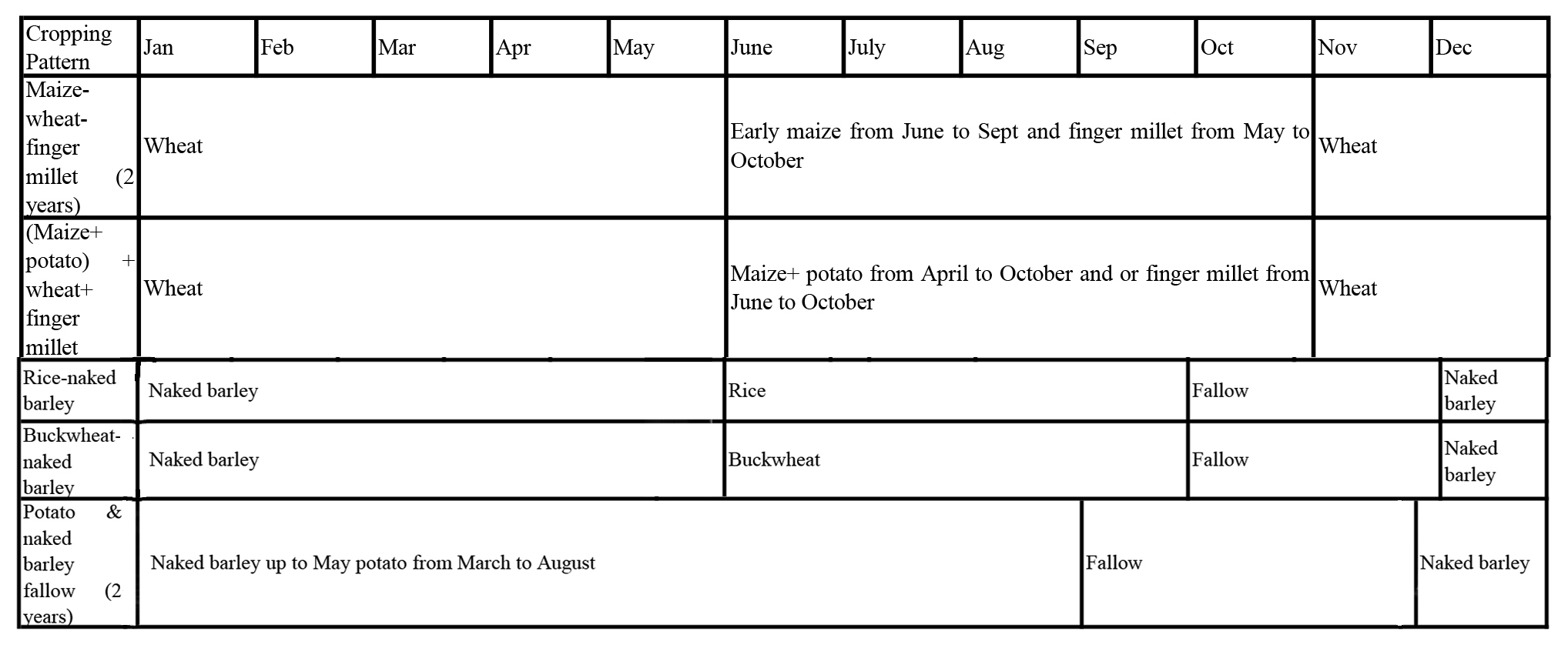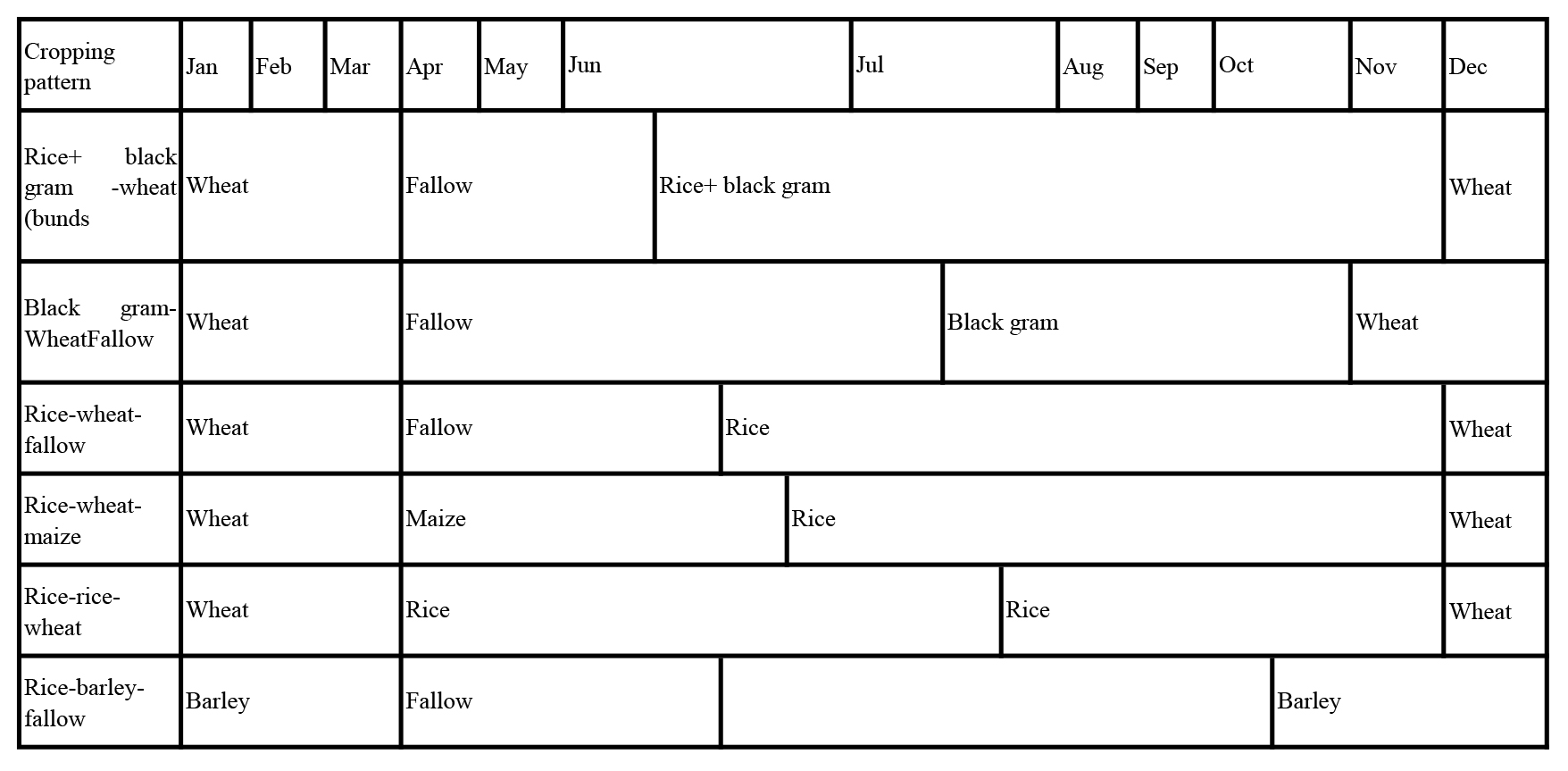
Farming system
Definition : Farming system is a mix of farm enterprises such as crop, livestock, aquaculture, agro forestry and fruit crops to which farm family allocates its resources in order to efficiently manage the existing environment for the attainment of the family goal.
The Crop Calendar is a tool that provides timely information about seeds to promote local crop production. It contains information on planting, sowing and harvesting periods of locally adapted crops in specific agro-ecological zones.
(i) Mountain farming systems:
The potato, barley and buckwheat zone is in the lower ranges of the Himalayas from 2 500 – 3 500 m above sea level. The land is steep and less fertile than in other zones. Land holdings are small and fragmented. Crops take longer to mature, and harvesting one crop annually is the common practice. Crop productivity is very low and intensification to increase yields has limited scope. Cereals, for example, have to be purchased from outside the region. Transhumant animal production is concentrated in alpine meadows and forests. The chyangra goat, bhyanglung sheep, lulu and kirko cattle, chauri, Tibetan horse, yak and nak predominates animals. The productivity of livestock is lower than in the Terai or hills. Households keep 5 –20 cattle and 50 or more small ruminants (goat and sheep).
Farmers in this zone derive their income mainly from livestock, but neither animal nor crop production can meet their basic needs. Many young people move to lower, more favourable altitudes to farm, or go abroad to find work. There are few educational opportunities for children. Generally, mountain farmers have little or no access to roads, electricity, markets or modern communication systems. In these remote areas, the main ethnic groups are the Sherpa, Limbu, and Tamang who are adapted to the hardships of the mountain-farming environment that include a cold climate and food shortages.
Table: Major cropping patterns in rainfed bari-land in the mountain region of Nepal

Table: Major cropping patterns in irrigated khet-land in the Mountain region of Nepal
ii) Hill farming systems of Nepal:
Hill farming systems are true examples of mixed crop-livestock production utilizing forest resources at elevations of 500 – 2 500 m above sea level. The combination of topography, wind, rainfall distribution, soils, and solar radiation has given rise to unique and complex systems incorporating traditional practices and experiences. The terrain is rugged and transport, communications, and livestock are all intertwined with the agro-ecological conditions to form micro-farming systems which differ between locations.
In the lower hill belt, water is available for irrigation, and rice is grown on terraces at least once a year. It seems that 1 800 m is tentatively the upper economic limit for rice, except in Jumla, where the crop is grown at 2 500 m above sea level. Rice is usually followed by winter wheat under irrigation. Other cash crops such as potatoes and vegetables, that command higher prices, are slowly replacing winter wheat. Tropical fruits are also grown in this belt. The unirrigated upland (bari) land, has been used to grow maize, finger millet, cowpeas, mustard, vegetables, oranges, lemons, plums, pears, mangoes, guavas, bananas, pineapples, sugarcane, tobacco, barley, wheat, fodder trees, and forages such as oats, vetch, and Stylosanthes spp. There is a moderate use of chemical fertilizers but extensive use of manure.
The predominant animals are cattle, buffalo, and goats, which are mostly stall-fed with crop residues supplemented with foliage from trees grown on the slopes of terraces and in the forest. Bullocks are used for draught for almost all cultivation, and for threshing of rice and millet. Rice straw constitutes the main source of feed, with milking animals being supplemented with ‘kundo’, a concentrate made from the byproducts of grain and oilseeds. In the upper hill belt, maize, millet, mustard, black gram, horse gram, and soybean are the predominant crops. Most of the citrus produced in Nepal is grown in this area.
The women are responsible for carrying fodder from the forest and for the feeding, milking, and management of livestock as well as the preparation of various milk products. Agricultural operations such as clearing and plowing the land are shared with the men. The cultivated land is steep in this zone and depending on rainfall, is more difficult to work. Farmers cultivate the land around the village at the start of the summer rains. In the upper hill belt, transhumant rearing animals exist; stock is taken to higher pastoral areas for grazing, moving from place to place during summer. They are brought down to the village at harvesting time and allowed to graze in the fields, where temporary sheds are erected for manure collection.
Table: Major cropping patterns in rainfed bari-land in the Hills of Nepal

Table: Major cropping pattern in the irrigated khet-land in the Hills of Nepal

iii) Terai farming systems of Nepal:
The Terai contributes 47% to the agricultural GDP of Nepal, which is the highest of the three major agro-ecological zones. Crops provide about 80% of the household income and dominate agricultural production in the Terai. The contribution of livestock to household income is estimated to be around 20%. The land is flat and fertile and is suitable for the cultivation of rice, the major crop. The area lies in an east-west direction in the southern part of Nepal and occupies about 58% of the cultivated land. Most of the flat land in the Terai is situated at an elevation of 70-300 m.
Most of the Terai households keep cattle; nearly 50% keep goats and over one-third keep buffalo. Although mechanization is replacing draught animal power, most of the poor and middle-level farmers still depend on draught animal power for various agricultural operations. Crop intensification in the Terai is high, with as many as three crops produced in a year. Consequently, an imbalance between organic matter and micronutrients is occurring in the soils.
Table. Major Cropping Pattern in the Bari land of Terai in Nepal

Table: Major Cropping Pattern in the Irrigated land of Terai in Nepal










